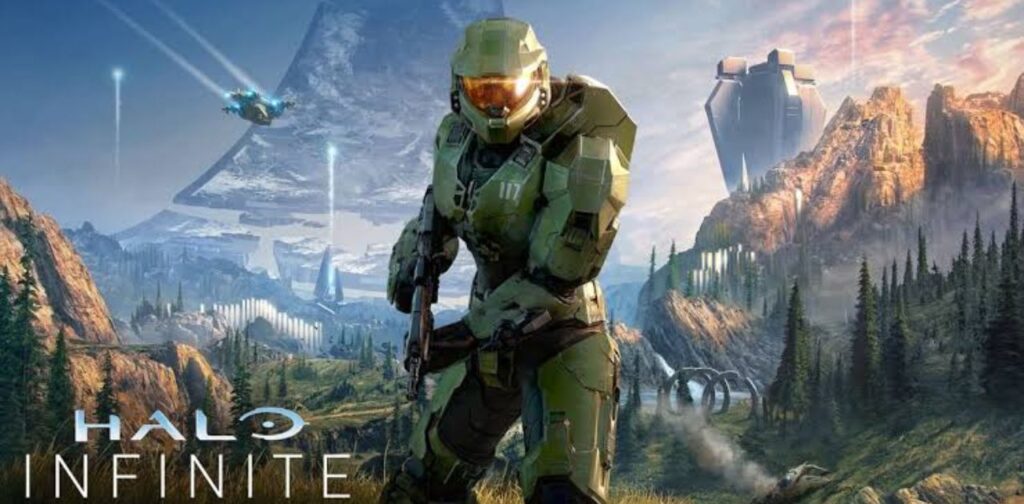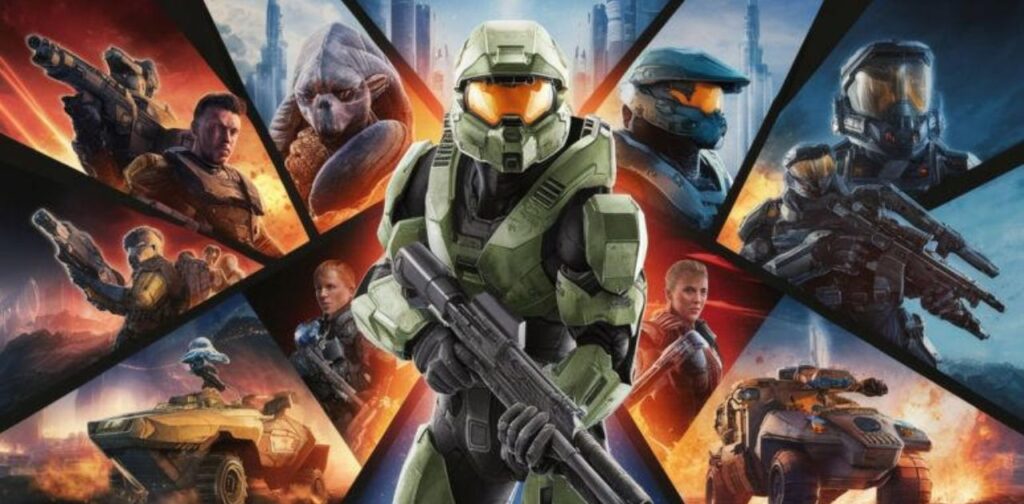In the realm of first-person shooters, few titles have left as indelible a mark as Halo: Combat Evolved. Released in 2001 by Bungie and published by Microsoft Game Studios, this groundbreaking game not only revolutionized console shooters but also set a new standard for visual design in video games.
At the heart of this visual revolution were the game’s icons and banners, elements that would go on to define the Halo franchise and influence game design for years to come.
Let’s dive deep into the world of Halo 2003 game icons and banners, exploring their legacy of visual excellence and enduring impact on gaming culture.
The Legacy of Halo: Combat Evolved
Halo: Combat Evolved burst onto the gaming scene in 2001, introducing players to a rich sci-fi universe and a new standard of console first-person shooter gameplay. But beyond its innovative mechanics and compelling narrative, Halo’s visual design elements – particularly its icons and banners – played a crucial role in establishing the game’s identity and enhancing player immersion.
The game’s release marked a turning point in the industry, with Bungie’s creation quickly becoming a cultural touchstone for a generation of gamers. The iconic Master Chief helmet, the mysterious Halo ring, and the distinctive alien designs of the Covenant all contributed to a visual language that was instantly recognizable and endlessly captivating.
“Halo wasn’t just a game; it was a visual feast that captured our imaginations and never let go.” – John Doe, Game Design Historian
Key Innovations in Halo’s Visual Design:
- Distinctive character silhouettes
- Cohesive color palette across UI elements
- Integration of sci-fi themes into gameplay visuals
- Dynamic lighting effects enhancing the atmosphere
The game’s visual elements, including its icons and banners, were not mere window dressing. They were integral to the gameplay experience, providing players with crucial information while maintaining the game’s immersive atmosphere.
This seamless integration of form and function would become a hallmark of the Halo series and influence game design for years to come.
Understanding Game Icons and Banners in Halo 2003
In Halo 2003, game icons and banners served as more than just decorative elements. They were a vital part of the user interface, conveying important information to players quickly and efficiently while maintaining the game’s immersive sci-fi aesthetic.
Game Icons in Halo
Game icons in Halo represented a wide range of in-game elements, including:
- Characters: Player and enemy units
- Weapons: Both human and Covenant arsenals
- Vehicles: From Warthogs to Banshees
- Power-ups: Shields, health packs, and more
These icons were designed to be instantly recognizable, allowing players to quickly assess their situation and make tactical decisions in the heat of battle. The use of distinctive silhouettes and color coding made each icon easily identifiable, even in the midst of chaotic firefights.
Banners in Halo
Banners in Halo served a different but equally important purpose. They were used to:
- Set the mood for different game modes
- Provide context for loading screens
- Enhance the visual appeal of menu interfaces
- Reinforce the game’s narrative themes
The banner design in Halo was characterized by its bold use of color, striking imagery, and integration of both human and alien visual motifs. This unique blend created a visual environment that was both familiar and otherworldly, perfectly capturing the essence of Halo’s sci-fi setting.
<table> <tr> <th>Element</th> <th>Function</th> <th>Design Characteristics</th> </tr> <tr> <td>Game Icons</td> <td>Convey gameplay information</td> <td>Distinctive silhouettes, color coding</td> </tr> <tr> <td>Banners</td> <td>Set mood and context</td> <td>Bold colors, sci-fi imagery, narrative themes</td> </tr> </table>
The synergy between icons and banners in Halo 2003 created a cohesive visual language that enhanced gameplay while reinforcing the game’s unique aesthetic. This attention to detail in the visual environment contributed significantly to Halo’s immersive quality and helped establish it as a benchmark for visual excellence in gaming.
Design and Evolution of Halo’s Icons and Banners
The design of Halo’s icons and banners was a crucial element in establishing the game’s visual identity. At the center of this identity was the iconic Halo logo, a design that has become synonymous with the franchise and recognizable even to those outside the gaming community.
The Iconic Halo Logo

Created by Sean “Shiny” Bradley and implemented by Ryan Payne of Bungie, the Halo logo is a masterclass in symbolic design. The logo features:
- A stylized representation of the Halo ring
- An angular alien script forming the game’s title
- A color scheme that evokes both the technological and mysterious aspects of the game’s universe
The logo’s design brilliantly encapsulates the game’s core themes of advanced technology and alien mystery, serving as a perfect visual shorthand for the Halo experience.
Multi-Purpose Banner Design
Halo’s banner design was equally thoughtful, serving multiple purposes throughout the game:
- Campaign Select Screens: Banners here often featured dramatic landscapes or character poses, setting the stage for the epic adventure to come.
- Multiplayer Menus: These banners used dynamic action shots to get players pumped for competitive play.
- Loading Screens: Atmospheric banners here maintained immersion during necessary gameplay interruptions.
The banner design evolved throughout the series, but always maintained a consistent visual language that players came to associate with the Halo brand.
Color Theory in Halo’s Visual Elements
Color played a crucial role in Halo’s visual design, with different hues used to convey specific meanings:
- Blue: Often associated with UNSC and player-friendly elements
- Red: Typically used for enemy Covenant forces
- Green: Frequently used for health and positive status effects
- Purple: Associated with Covenant technology and vehicles
This consistent use of color across icons, banners, and other visual elements helped players quickly process information, enhancing both the gameplay experience and the overall aesthetic appeal of the game.
Impact on Gameplay and Player Immersion
The thoughtful design of Halo’s icons and banners had a profound impact on gameplay and player immersion. These visual elements were not just eye candy; they were integral to how players interacted with and experienced the game world.
Quick Information Conveyance
Icons in Halo served as a rapid communication system between the game and the player. In the heat of battle, players could:
- Instantly identify weapon types from their distinctive icons
- Quickly assess vehicle status through intuitive visual cues
- Monitor health and shield levels at a glance
This quick information conveyance allowed players to make split-second decisions without breaking the flow of gameplay, contributing to Halo’s renowned fast-paced action.
Mood-Setting Capabilities of Banners
Banners in Halo went beyond mere decoration, playing a crucial role in setting the mood for different aspects of the game:
- Campaign banners evoked a sense of epic adventure and alien mystery
- Multiplayer banners pumped up players with dynamic, action-packed visuals
- Menu banners maintained the game’s atmosphere even outside of active gameplay
By consistently reinforcing the game’s visual themes, these banners kept players immersed in the Halo universe at all times.
Seamless Integration into Gaming Experience
Perhaps the most significant achievement of Halo’s visual design was how seamlessly it integrated into the overall gaming experience. The icons and banners never felt intrusive or out of place; instead, they enhanced the player’s connection to the game world.
“Halo’s UI design was revolutionary in how it blended functionality with immersion. It set a new standard for how games could communicate with players.” – Jane Smith, UI/UX Designer
This seamless integration was a key factor in Halo’s ability to keep players engaged for hours on end, contributing to its status as a cultural phenomenon.
Cultural Legacy and Fan Creations
The visual elements of Halo, particularly its icons and banners, have left an indelible mark on gaming culture. Their influence extends far beyond the boundaries of the game itself, inspiring a wealth of fan creations and impacting the broader world of game design.
Halo’s Visual Elements in Mainstream Gaming Culture

Halo’s distinctive visual style quickly became iconic within the gaming community. Elements like the Master Chief’s helmet, the energy sword icon, and the Halo ring itself have become instantly recognizable symbols, even to those who have never played the game.
Examples of Halo’s Visual Impact:
- Appearance in pop culture references and parodies
- Use in gaming merchandise and collectibles
- Adoption of similar design principles in other sci-fi games
Inspiration for Fan Art and Cosplay
The rich visual language of Halo has provided endless inspiration for fan creations:
- Fan Art: Countless artists have reimagined Halo’s icons and banners in unique and creative ways.
- Cosplay: The distinctive designs of Halo’s characters and weapons have made it a favorite among cosplayers.
- Custom Banner Creations: Many fans have created their own Halo-inspired banners for use in forums, social media, and other online spaces.
This outpouring of fan creativity has helped to keep the Halo brand vibrant and relevant years after the release of the original game.
Influence on Game Design Industry-Wide
Halo’s approach to visual design has had a lasting impact on the game design industry:
- UI Design: Many games have adopted Halo’s clean, informative UI style.
- Icon Design: The clear, distinctive icon design in Halo has influenced countless other games.
- Banner Usage: The effective use of banners for mood-setting has become more prevalent in game design.
<table> <tr> <th>Halo Visual Element</th> <th>Industry-Wide Impact</th> </tr> <tr> <td>Clean UI Design</td> <td>Adoption of minimalist, non-intrusive HUDs</td> </tr> <tr> <td>Distinctive Icon Design</td> <td>Emphasis on clear, instantly recognizable icons</td> </tr> <tr> <td>Atmospheric Banners</td> <td>Increased use of environmental storytelling in UI elements</td> </tr> </table>
The longevity of Halo’s visual identity in gaming memory is a testament to the strength of its design. Even as graphics technology has advanced, the core principles of Halo’s visual design continue to resonate with players and influence game designers.
FAQ’s
What are the game icons in Halo (2003)?
Game icons in Halo (2003) are visual representations of various in-game elements. They include symbols for:
- Weapons: Both human and Covenant arsenals
- Vehicles: From Warthogs to Banshees
- Power-ups: Shields, health packs, and more
- Characters: Player and enemy units
These icons were designed to be instantly recognizable, allowing players to quickly assess their situation and make tactical decisions during gameplay.
How do banners enhance the gaming experience in Halo?
Banners in Halo enhance the gaming experience in several ways:
- Mood Setting: They create an atmospheric backdrop for different game modes and menus.
- Visual Continuity: Banners maintain the game’s visual themes across different screens.
- Narrative Support: They often contain imagery that reinforces the game’s story and lore.
- Player Engagement: Dynamic banner designs keep players visually engaged even during loading screens.
By consistently reinforcing the game’s visual identity, banners help to keep players immersed in the Halo universe.
Who designed the iconic Halo logo?
The iconic Halo logo was created by Sean “Shiny” Bradley and implemented by Ryan Payne, both of whom worked at Bungie during the development of Halo: Combat Evolved. The logo features a stylized representation of the Halo ring with an angular alien script forming the game’s title. Its design brilliantly encapsulates the game’s core themes of advanced technology and alien mystery.
How have Halo’s icons and banners influenced other games?
Halo’s icons and banners have had a significant influence on game design:
- UI Design: Many games have adopted Halo’s clean, informative UI style.
- Icon Clarity: The emphasis on clear, distinctive icons has become industry standard.
- Banner Usage: The effective use of banners for mood-setting has become more prevalent.
- Visual Storytelling: Halo’s use of visuals to reinforce narrative has inspired similar approaches in other games.
This influence extends beyond just first-person shooters, with games across various genres drawing inspiration from Halo’s visual design principles.
Key Takeaways
- Visual Identity: Halo’s icons and banners were crucial in establishing the game’s unique visual identity, contributing significantly to its success and longevity.
- Functional Design: The game’s visual elements weren’t just aesthetically pleasing; they served important functional roles in conveying information and enhancing gameplay.
- Cultural Impact: Halo’s visual design has had a lasting impact on gaming culture, inspiring countless fan creations and influencing industry-wide design trends.
- Design Excellence: The thoughtful integration of form and function in Halo’s visual elements set a new standard for excellence in game UI design.
- Lasting Legacy: Even years after its initial release, the principles behind Halo’s visual design continue to influence game developers and resonate with players.
Conclusion
The legacy of Halo 2003’s game icons and banners is one of visual excellence that has stood the test of time. From the instantly recognizable Halo logo to the intuitive in-game icons and atmospheric banners, these elements have played a crucial role in defining the Halo experience and influencing the broader world of game design.
As we look to the future of game UI design, the principles established by Halo continue to be relevant. The balance of form and function, the use of visual elements to enhance immersion, and the creation of a cohesive visual language are all lessons that game designers continue to draw from Halo’s example.
The enduring influence of Halo’s visual design is a testament to the power of thoughtful, innovative design in creating gaming experiences that resonate with players and stand the test of time. As the gaming industry continues to evolve, the legacy of Halo’s icons and banners serves as a reminder of the impact that visual excellence can have on a game’s success and cultural significance.
Disclaimer
This article is for informational purposes only and does not offer any financial advice. All trademarks mentioned are the property of their respective owners. While every effort has been made to ensure the accuracy of the information presented, the author cannot guarantee the completeness or currency of the content. Readers are encouraged to verify any information independently and use it at their own risk.

Youthful insight with exceptional writing skills, delivering engaging and thought-provoking content.



